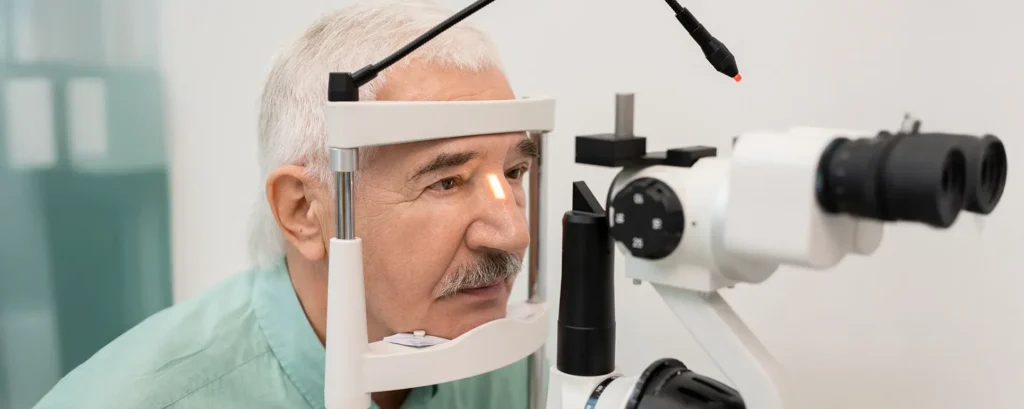If you’ve been through pancreatitis, or you’re living with it long term, you probably already know how much this condition can affect the rest of your body. What many people don’t realise, though, is that pancreatitis can also have knock-on effects on your eyes. Cataracts, which cause the lens of your eye to become cloudy, are most often thought of as an age-related problem. But certain health conditions and treatments—including those linked to pancreatitis—can speed up their development.
So in this guide, we’ll look at the connections between pancreatitis and cataracts. We’ll explore how diabetes after pancreatitis, long-term steroid treatment, and nutritional changes might influence your eyes. We’ll also go through what you should keep in mind if cataract surgery is ever needed. By the end, you’ll have a clearer picture of how these two conditions can overlap and, more importantly, what you can do to stay on top of your eye health.
What exactly is a cataract?
A cataract is simply clouding of your eye’s natural lens. The lens is normally clear and allows light to pass through so you can see sharp, detailed images. Over time, proteins in the lens can clump together, leading to cloudy patches that gradually spread. At first, you may notice glare from lights at night, or colours looking faded and less vibrant. Later, cataracts can make your vision blurry or hazy, and glasses won’t seem to help much.
Most cataracts happen with age, but other factors can make them appear earlier or progress faster. These include smoking, diabetes, long-term steroid use, heavy alcohol intake, and in rarer cases, certain nutritional deficiencies. If you’ve had pancreatitis, you may recognise more than one of those factors as something you’ve had to deal with.
A quick recap: what does pancreatitis do to the body?

Pancreatitis is inflammation of the pancreas, an organ that plays a vital role in digestion and blood sugar control. It can come on suddenly (acute pancreatitis) or develop gradually over time (chronic pancreatitis). Beyond the pain and digestive issues it causes, pancreatitis can also leave lasting effects that ripple out to other parts of the body.
Here are the three main ways it can tie into your eye health:
- Diabetes after pancreatitis (type 3c diabetes): Damage to the pancreas can reduce insulin production, leaving you with unstable blood sugars. Diabetes of any type raises the risk of cataracts.
- Steroid treatment for autoimmune pancreatitis: Steroids can bring inflammation under control but also increase the risk of certain cataracts, especially posterior subcapsular cataracts.
- Nutritional deficiencies from malabsorption: If your pancreas isn’t making enough digestive enzymes, you might not absorb vitamins properly. Some of these vitamins are important for healthy eyes and recovery after surgery.
So while pancreatitis itself doesn’t directly cause cataracts, it can stack up risk factors that make them more likely.
Diabetes after pancreatitis: why it matters for your eyes
One of the most common long-term complications of pancreatitis is diabetes, sometimes called type 3c or pancreatogenic diabetes. This form of diabetes happens because the pancreas no longer produces enough insulin. Unlike type 2 diabetes, which is often linked to weight and lifestyle, type 3c can happen even in people who are otherwise slim and active.
Diabetes is one of the strongest risk factors for cataracts. High blood sugar affects the lens of the eye by causing chemical changes in its proteins and drawing fluid into the lens, leading to swelling and clouding. People with diabetes tend to develop cataracts earlier in life, and they can progress more quickly compared to those without diabetes.
The good news is that careful blood sugar control makes a real difference. If your glucose levels stay within your target range, your risk of developing cataracts early is much lower than if sugars are persistently high. But even with the best control, the background risk remains higher than average, which is why regular eye checks are essential.
Steroids: double-edged treatment

For people with autoimmune pancreatitis, steroid treatment can be life-changing. Steroids reduce inflammation and stop the immune system attacking the pancreas. They’re often used at high doses to get the condition under control and then tapered down to a lower maintenance dose.
The flip side is that long-term steroids can increase the chance of cataracts, particularly a type called posterior subcapsular cataracts. These form at the back of the lens and can affect vision quite quickly, especially for reading and night driving. Unlike age-related cataracts, which often creep in slowly, steroid-induced cataracts can move faster.
If you’re on steroids, don’t be alarmed—you won’t automatically get cataracts. But it’s sensible to have regular eye checks and to mention any new symptoms like glare or blurred reading vision to your doctor. Sometimes, your medical team may be able to switch you onto a lower steroid dose or consider alternative treatments if side effects are a problem.
Nutrition, malabsorption, and the eye lens
The pancreas doesn’t just regulate blood sugar—it also makes enzymes that help you digest food. In chronic pancreatitis, the gland can lose its ability to release enough enzymes, a condition known as exocrine pancreatic insufficiency (EPI). When this happens, you can develop malabsorption, where food passes through without being fully digested.
Malabsorption often leads to deficiencies in fat-soluble vitamins (A, D, E, and K). For your eyes, vitamin A is particularly important. It plays a key role in night vision and maintaining a healthy ocular surface. Without it, you might notice poor night vision or dry, irritated eyes. Vitamin D is also crucial because it helps regulate calcium balance, and long-term disturbances in calcium metabolism have been linked to cataracts in rare cases.
If you’ve been prescribed pancreatic enzyme replacement therapy (PERT), taking it correctly with meals can make a big difference. It improves digestion, prevents nutrient deficiencies, and supports better overall health—including your eyes.
Alcohol, smoking, and their added impact
For many people, alcohol is a trigger for pancreatitis. After an attack, doctors usually recommend avoiding alcohol completely to prevent further damage. Alcohol itself has been linked with a higher risk of cataracts, especially with heavy drinking over many years.
Smoking is another factor that adds fuel to the fire. It increases oxidative stress in the eye, which accelerates cataract formation. If you’ve already had pancreatitis, smoking can also make your recovery harder and increase the risk of complications. Quitting smoking is one of the best decisions you can make for both your pancreatic and your eye health.
Cataract surgery if you’ve had pancreatitis
Modern cataract surgery is one of the safest operations in medicine, and having pancreatitis doesn’t mean you can’t have it. But it does mean your surgical team will want to pay attention to a few extra details.
Before surgery, it’s important to make sure your diabetes is reasonably controlled if you have it, your nutrition is stable, and your medication list is up to date. If you’re on steroids, your surgeon will want to know how much and for how long. If you have EPI, you might also be asked about how you take your enzymes and whether your weight is stable.
On the day of surgery, most people will just need numbing eye drops and possibly a light sedative. It’s a short procedure and you’ll usually go home the same day. After surgery, you’ll use eye drops to prevent inflammation and infection. Keeping blood sugars steady after the operation is especially important if you have diabetes, as it helps your eye heal smoothly.
Choosing a lens if you have diabetes after pancreatitis
During cataract surgery, your cloudy lens is replaced with an artificial one called an intraocular lens (IOL). Most people do well with a standard monofocal IOL, which gives clear distance vision but requires glasses for reading. If your retina is completely healthy and your diabetes is well controlled, you may also be a candidate for more advanced lens options.
That said, in people with diabetes, surgeons often recommend monofocal lenses for maximum clarity and contrast. This reduces the risk of visual problems if the retina develops complications later on. Your surgeon will discuss the best option based on your eyes and lifestyle.
How to lower your risk of cataracts
Even if pancreatitis has added some risks, there’s still plenty you can do to protect your eyes.
- Keep your blood sugar within your target range if you have diabetes.
- Take your pancreatic enzymes correctly if you’ve been prescribed them.
- Don’t smoke—quitting reduces cataract risk and protects your pancreas.
- Avoid alcohol after pancreatitis unless your doctor gives you the all-clear.
- Wear sunglasses with UV protection when you’re outdoors.
- Have regular eye checks so cataracts are picked up early.
FAQ: Common Questions
1) Does pancreatitis directly cause cataracts?
No, pancreatitis itself doesn’t directly cause cataracts. Instead, the condition can create circumstances that increase your risk. For example, damage to the pancreas can cause diabetes, which is strongly linked with earlier cataract development. Long-term steroid treatment, often used in autoimmune pancreatitis, can also make cataracts more likely. Malabsorption from pancreatic insufficiency can lead to deficiencies in vitamins needed for eye health, which may further influence cataract risk. So it’s less about the pancreatitis itself and more about the knock-on effects it creates in your body.
2) What are the first signs of cataracts I should look out for?
The earliest signs of cataracts are often quite subtle. Many people first notice increased glare, especially from headlights when driving at night. You might also find that colours don’t look as bright as they once did, or that you need stronger light to read comfortably. Over time, your vision may become misty, hazy, or blurred, and glasses or contact lenses stop helping. If you’ve had pancreatitis and are already dealing with diabetes or long-term steroids, it’s worth booking regular eye checks to catch cataracts early, even if your symptoms are mild.
3) If I have diabetes after pancreatitis, does that mean I’ll definitely get cataracts?
Not at all. Diabetes does increase the likelihood of developing cataracts, and they may appear earlier than in people without diabetes, but it’s not a guarantee. The key factor is how well your blood sugar is managed. Consistent glucose control, along with healthy lifestyle habits like not smoking and protecting your eyes from UV light, can help slow cataract development. So while your risk is higher than average, it’s far from certain that you’ll develop cataracts just because you have diabetes linked to pancreatitis.
4) Can steroid treatment for autoimmune pancreatitis damage my eyes?
Steroids are powerful medicines, and they can be both life-saving and problematic. In the case of autoimmune pancreatitis, they often bring the condition under control, but long-term use does raise the risk of cataracts, particularly the posterior subcapsular type. These can develop faster than age-related cataracts and may affect reading or night vision sooner. However, not everyone who takes steroids will get cataracts, and your doctors will aim to keep you on the lowest effective dose. Regular eye checks mean any cataract changes can be spotted and managed before they significantly affect your sight.
5) Should I take vitamin supplements to protect my eyes if I have malabsorption?
If you have pancreatic enzyme insufficiency and malabsorption, it’s tempting to take supplements just in case, but it’s best not to self-prescribe. Certain vitamins, like A and D, are important for eye health, but too much can actually cause harm. The safest route is to have your vitamin levels checked by your doctor or dietitian. If a deficiency is found, you’ll be given tailored advice on the right dose and type of supplement. Getting your enzyme replacement therapy right is often the most important first step in preventing deficiencies from happening in the first place.
6) Can calcium or vitamin D problems from pancreatitis lead to cataracts?
Yes, in some cases they can. If your pancreas isn’t absorbing nutrients properly, you might end up with low vitamin D, which affects calcium balance in your body. Over the long term, chronic problems with calcium and vitamin D can contribute to cataracts, although this is quite uncommon. It’s not the main way pancreatitis affects the eyes, but it’s another reminder of why keeping your nutrition in check is so important. Regular blood tests, enzyme therapy, and medical follow-up all help reduce the chances of this becoming a problem.
7) Can I still have cataract surgery if I’ve had pancreatitis?
Yes, you absolutely can. Cataract surgery is one of the safest procedures in modern medicine, and having pancreatitis in your history isn’t a barrier. What it does mean is that your surgeon will want to take a little extra care with your pre-operative checks. They’ll look at your blood sugar control if you have diabetes, review your steroid use, and ensure your nutrition is stable if you have enzyme insufficiency. With those things well managed, you can expect the same excellent results from cataract surgery as anyone else.
8) Do steroid eye drops after cataract surgery increase cataract risk?
No, short-term steroid eye drops used after cataract surgery don’t cause cataracts. They’re an important part of recovery because they reduce inflammation and protect against complications. The type of cataracts linked to steroids come from long-term systemic use, such as when you take tablets for autoimmune pancreatitis. The eye drops you’ll use after surgery are local, short-term, and carefully monitored by your surgeon. So while it’s sensible to mention your steroid history, the drops after cataract surgery are safe and shouldn’t be a cause for concern.
9) Do smoking and alcohol really make cataracts worse if I’ve had pancreatitis?
Yes, both smoking and heavy alcohol use add to cataract risk. Smoking is one of the strongest lifestyle risk factors for cataracts because it accelerates oxidative damage in the lens. Alcohol, particularly heavy long-term drinking, has also been linked with faster cataract development. If you’ve had pancreatitis, your doctors will almost certainly advise avoiding alcohol to protect your pancreas anyway. Quitting smoking and cutting out alcohol therefore gives you a double benefit: protecting both your pancreas and your eyes at the same time.
10) Are premium lenses an option if I have diabetes from pancreatitis?
It depends. Premium intraocular lenses, like multifocal or extended depth lenses, can reduce your need for glasses, but they work best when the retina is perfectly healthy. If your diabetes hasn’t affected your retina and your sugars are well controlled, these lenses may still be an option. However, many surgeons prefer to recommend monofocal lenses in people with diabetes because they offer the sharpest contrast and the most predictable results, even if retinal changes occur in the future. Your surgeon will talk through the choices and help you find the best fit for your situation
Final Thoughts
While pancreatitis doesn’t directly cause cataracts, the complications that often come with it—diabetes, steroid treatment, and malabsorption—can all increase your risk. The best way forward is to manage these risks carefully, have regular eye checks, and make healthy lifestyle choices. If you do develop cataracts, modern surgery is safe and effective, even if you’ve had pancreatitis. With the right planning, you can look forward to clear vision again.
If you’re considering surgery or want to discuss your options, our team at London Cataract Centre can guide you through every step and make sure your care is tailored to your needs.
References
- Diabetes UK (n.d.). What is type 3c diabetes? [online] Available at: https://www.diabetes.org.uk/about-diabetes/other-types-of-diabetes/type3c-diabetes [Accessed 28 Aug. 2025].
- Hart, P.A., Bellin, M.D., Andersen, D.K., Bradley, D., Cruz-Monserrate, Z., Forsmark, C.E., et al. (2016). Type 3c (pancreatogenic) diabetes mellitus secondary to chronic pancreatitis and pancreatic cancer. The Lancet Gastroenterology & Hepatology, 1(3), 226–237. Available at: https://pmc.ncbi.nlm.nih.gov/articles/PMC5495015/ [Accessed 28 Aug. 2025].
- Phillips, M.E., Hopper, A.D., Leeds, J.S., Hennessy, M., Barclay, A., Lobo, A.J., et al. (2021). Consensus for the management of pancreatic exocrine insufficiency: UK practical guidelines. BMJ Open Gastroenterology, 8(1), e000643. Available at: https://bmjopengastro.bmj.com/content/8/1/e000643 [Accessed 28 Aug. 2025].
- Carlson, J., Iovieno, A. and Kymionis, G. (2022). Drugs associated with cataract formation represent an unmet need in pharmacovigilance. Frontiers in Medicine, 9, 947659. Available at: https://www.frontiersin.org/journals/medicine/articles/10.3389/fmed.2022.947659/full [Accessed 28 Aug. 2025].
- Ghanchi, F. and Clews, S.J. (2013). The Royal College of Ophthalmologists’ clinical guidelines for diabetic retinopathy: a summary. Eye (London), 27(2), 285–287. Available at: https://pmc.ncbi.nlm.nih.gov/articles/PMC3574265/ [Accessed 28 Aug. 2025].

